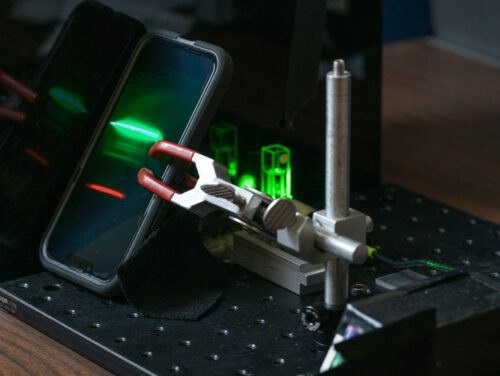Pocket-Sized Invention Revolutionizes Ability to Swiftly Detect Pathogens in Hospital Setting
|
By HospiMedica International staff writers Posted on 17 Jul 2024 |

Traditionally, the detection of pathogens in a hospital environment could take several days. Now, a new technology combining a cellphone camera with a Raman spectrometer—a sophisticated laser-based chemical analysis tool—enables the rapid detection of drugs, chemicals, and biological molecules that are invisible to the naked eye.
Engineers at Texas A&M University Engineering (College Station, TX, USA) have developed a handheld cellphone-based Raman spectrometer system. This device allows for the non-invasive identification of potentially hazardous chemicals or materials directly in the field, particularly beneficial in remote locations where traditional, larger laboratory spectrometers are impractical due to their size and power requirements. This innovative Raman spectrometer system incorporates lenses, a diode laser, and a diffraction grating—a compact, square-shaped surface that disperses light for analysis—along with a standard cellphone camera to capture the Raman spectrum. The resulting spectrum’s peaks provide detailed information about the chemical makeup and molecular structure of a substance based on the intensity and location of these peaks.
To operate the device, a cellphone is positioned behind the transmission grating with the camera aligned to capture the Raman spectrum. A laser directs a beam at a sample, such as a bacterium placed on a slide. The cellphone camera records the resulting spectrum. When combined with a dedicated cellphone app/database, this portable device facilitates immediate on-site identification of materials. Previously, such identification required collecting extensive biological samples for laboratory analysis, which could take many hours or days. Unlike traditional Raman spectrometers, which can cost thousands of dollars, this new device is significantly more affordable and can identify materials much more quickly.
“It’s a small device that can tell you the composition of a particular system, material or sample,” said Dr. Peter Rentzepis, a professor in the Department of Electrical and Computer Engineering at Texas A&M University, who holds a patent for the hand-held cellphone-based Raman spectrometer system. “You can even have it in your pocket.”
Related Links:
Texas A&M University Engineering

Latest Critical Care News
- Novel Cannula Delivery System Enables Targeted Delivery of Imaging Agents and Drugs
- Ingestible Smart Capsule for Chemical Sensing in the Gut Moves Closer to Market
- Novel Intrabronchial Method Delivers Cell Therapies in Critically Ill Patients on External Lung Support
- Generative AI Technology Detects Heart Disease Earlier Than Conventional Methods
- Wearable Technology Predicts Cardiovascular Risk by Continuously Monitoring Heart Rate Recovery
- Wearable Health Monitoring Device Measures Gases Emitted from and Absorbed by Skin
- Groundbreaking Technology Rapidly Detects Airborne Influenza Viruses
- Handheld Device Could Transform Heart Disease Screening
- Flexible Semi-Autonomous Robot Could Deliver Medicine Inside Body

- Neurorestorative Treatment Strategies Hold Promise for Most Severe Forms of Epilepsy
- Gene Discovery Could Help Grow New Heart Arteries
- Study Discovers Invisible Transmission of Common Hospital-Associated Infection
- Non-Invasive Neuro-Ophthalmology Techniques Could Detect Brain Tumors Earlier
- Mass Manufactured Nanoparticles to Deliver Cancer Drugs Directly to Tumors
- World’s Smallest Pacemaker Fits Inside Syringe Tip

- AI-Powered, Internet-Connected Medical Devices to Revolutionize Healthcare, Finds Study
Channels
Surgical Techniques
view channel
Pioneering Sutureless Coronary Bypass Technology to Eliminate Open-Chest Procedures
In patients with coronary artery disease, certain blood vessels may be narrowed or blocked, requiring a stent or a bypass (also known as diversion) to restore blood flow to the heart. Bypass surgeries... Read more
Intravascular Imaging for Guiding Stent Implantation Ensures Safer Stenting Procedures
Patients diagnosed with coronary artery disease, which is caused by plaque accumulation within the arteries leading to chest pain, shortness of breath, and potential heart attacks, frequently undergo percutaneous... Read more
World's First AI Surgical Guidance Platform Allows Surgeons to Measure Success in Real-Time
Surgeons have always faced challenges in measuring their progress toward surgical goals during procedures. Traditionally, obtaining measurements required stepping out of the sterile environment to perform... Read morePatient Care
view channel
Portable Biosensor Platform to Reduce Hospital-Acquired Infections
Approximately 4 million patients in the European Union acquire healthcare-associated infections (HAIs) or nosocomial infections each year, with around 37,000 deaths directly resulting from these infections,... Read moreFirst-Of-Its-Kind Portable Germicidal Light Technology Disinfects High-Touch Clinical Surfaces in Seconds
Reducing healthcare-acquired infections (HAIs) remains a pressing issue within global healthcare systems. In the United States alone, 1.7 million patients contract HAIs annually, leading to approximately... Read more
Surgical Capacity Optimization Solution Helps Hospitals Boost OR Utilization
An innovative solution has the capability to transform surgical capacity utilization by targeting the root cause of surgical block time inefficiencies. Fujitsu Limited’s (Tokyo, Japan) Surgical Capacity... Read more
Game-Changing Innovation in Surgical Instrument Sterilization Significantly Improves OR Throughput
A groundbreaking innovation enables hospitals to significantly improve instrument processing time and throughput in operating rooms (ORs) and sterile processing departments. Turbett Surgical, Inc.... Read moreHealth IT
view channel
Printable Molecule-Selective Nanoparticles Enable Mass Production of Wearable Biosensors
The future of medicine is likely to focus on the personalization of healthcare—understanding exactly what an individual requires and delivering the appropriate combination of nutrients, metabolites, and... Read more
Smartwatches Could Detect Congestive Heart Failure
Diagnosing congestive heart failure (CHF) typically requires expensive and time-consuming imaging techniques like echocardiography, also known as cardiac ultrasound. Previously, detecting CHF by analyzing... Read moreBusiness
view channel
Expanded Collaboration to Transform OR Technology Through AI and Automation
The expansion of an existing collaboration between three leading companies aims to develop artificial intelligence (AI)-driven solutions for smart operating rooms with sophisticated monitoring and automation.... Read more















